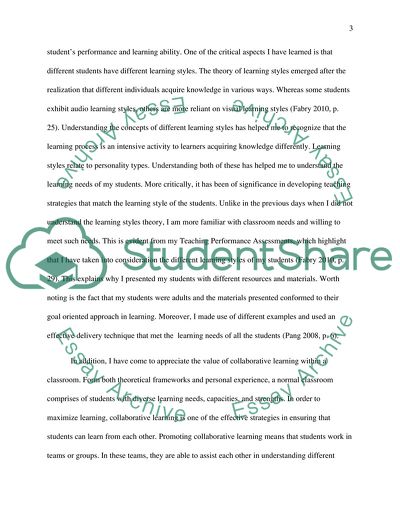Cite this document
(A Critical Reflection on Teaching Practice Assessment Essay Example | Topics and Well Written Essays - 2250 words, n.d.)
A Critical Reflection on Teaching Practice Assessment Essay Example | Topics and Well Written Essays - 2250 words. https://studentshare.org/education/1855420-this-assessment-requires-a-critical-reflection-on-your-own-experiences-of-learning-teaching-and-assessment-the-critical-reflection-can-draw-on-evidence-from-the-tpas-teaching-practice-assessment-formative-assessments-micro-teach-activity-interaction
A Critical Reflection on Teaching Practice Assessment Essay Example | Topics and Well Written Essays - 2250 words. https://studentshare.org/education/1855420-this-assessment-requires-a-critical-reflection-on-your-own-experiences-of-learning-teaching-and-assessment-the-critical-reflection-can-draw-on-evidence-from-the-tpas-teaching-practice-assessment-formative-assessments-micro-teach-activity-interaction
(A Critical Reflection on Teaching Practice Assessment Essay Example | Topics and Well Written Essays - 2250 Words)
A Critical Reflection on Teaching Practice Assessment Essay Example | Topics and Well Written Essays - 2250 Words. https://studentshare.org/education/1855420-this-assessment-requires-a-critical-reflection-on-your-own-experiences-of-learning-teaching-and-assessment-the-critical-reflection-can-draw-on-evidence-from-the-tpas-teaching-practice-assessment-formative-assessments-micro-teach-activity-interaction.
A Critical Reflection on Teaching Practice Assessment Essay Example | Topics and Well Written Essays - 2250 Words. https://studentshare.org/education/1855420-this-assessment-requires-a-critical-reflection-on-your-own-experiences-of-learning-teaching-and-assessment-the-critical-reflection-can-draw-on-evidence-from-the-tpas-teaching-practice-assessment-formative-assessments-micro-teach-activity-interaction.
“A Critical Reflection on Teaching Practice Assessment Essay Example | Topics and Well Written Essays - 2250 Words”. https://studentshare.org/education/1855420-this-assessment-requires-a-critical-reflection-on-your-own-experiences-of-learning-teaching-and-assessment-the-critical-reflection-can-draw-on-evidence-from-the-tpas-teaching-practice-assessment-formative-assessments-micro-teach-activity-interaction.


